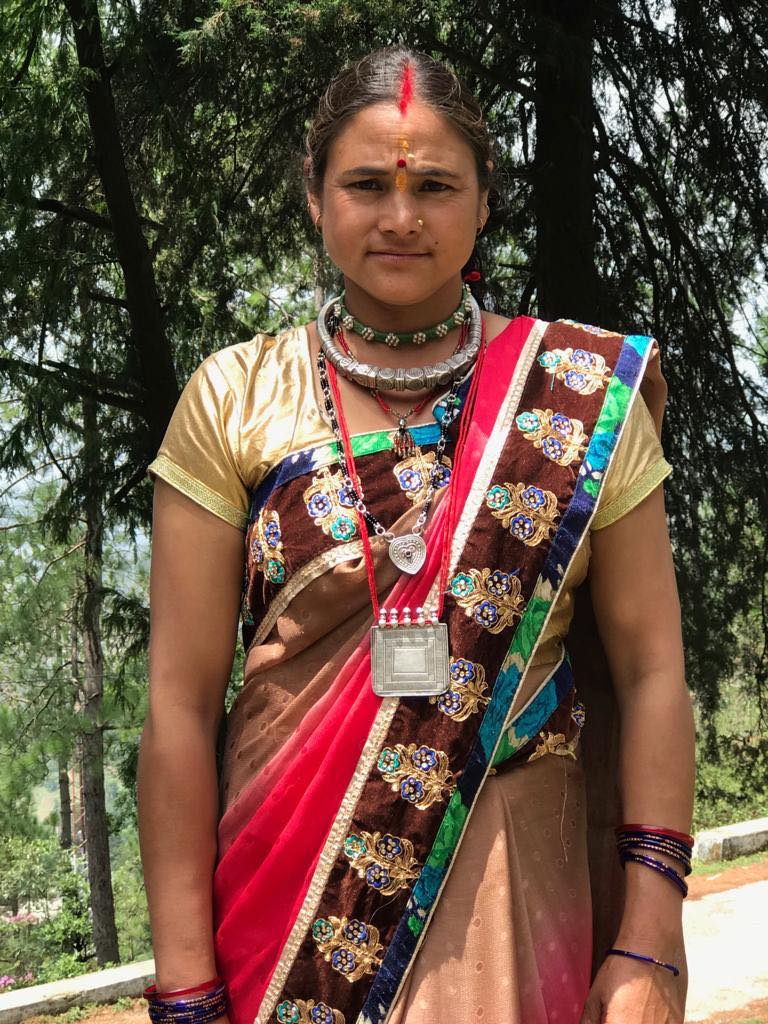Pahadi women adore oversized jewelry, which serves as a symbol of their social and financial standing, with gold being a sign of wealth and silver for those from less affluent backgrounds. To preserve the metals, Kumayoni and Garwali artisans often overlay designs with brass. Among the most iconic pieces is the nose ring (Nathuli), a cultural heirloom passed down from the maternal uncle to the bride on her wedding day. The weight and number of pearls on the Nathuli signify the family's status. Tehri Nath from Garhwal, renowned for its intricate stone work and Kundan embellishments, stands out, while larger nose rings are favored in regions like Jaunsar, Bawar, and Jaunpur. Additionally, Bulaq, worn at the nasal septum, is a must-have for women in Kumayon, Jaunsar, and Garhwal.
Pahadi Jewelry adds charm to your look, reflecting Uttarakhand's cultural heritage. In today's society, many still cherish traditional ornaments, with Uttarakhand Jewelry being their preferred choice. Uttarakhand's traditional Pahadi jewelry is highly favored by women. Exploring the rich cultural legacy of Uttarakhand, we delve into the distinctive designs of Kumaoni and Garhwali jewelry, crafted in gold and silver. Renowned for its scenic beauty and traditional adornments, Uttarakhand holds a special place in jewelry enthusiasts' hearts.
Moving on to necklaces, the Chandrahaar is a majestic gold necklace comprising five chains of golden beads, often adorned with Kundan clasps and available either in pure gold or gemstone embellished designs. The Sikka Mala, also known as Kaldaar, is a popular choice across Himalayan regions, featuring a string of coins. Another notable piece, the Hansuli, sits gracefully on the collar and is worn in various Himalayan regions including Uttarakhand, Himachal Pradesh, and Nepal. The Gulibandh, a diamond-studded choker, enjoys popularity not only in Uttarakhand's Kumaon district but also in other parts of India. Additionally, necklaces like Munra, Soota, and Mala crafted from silver, and Tominia made from gold, have their origins in this region.
Various designs and patterns of Pahadi Jewellery are found across different regions of Uttarakhand, showcasing both similarities and unique features between Kumaoni and Garhwali styles. Despite this rich heritage, there's a decreasing demand for traditional Uttarakhand jewelry and ornaments. The younger generation is gravitating towards modern designs, but in doing so, they are overlooking the elegance and significance of the old traditional jewelry designs unique to Uttarakhand. While contemporary designs are readily available, they lack the historical and cultural value of traditional ones.
Newly Married Bride with Pahadi Jewellery
The bride from the Kumaon region adorns herself with traditional Kumaoni Jewelry. The northern regions of India, particularly the hills of Uttarakhand and Himachal Pradesh, boast a rich heritage and enduring traditions. One can truly experience this cultural richness by attending weddings or traveling to these picturesque hill areas.
The Pahadi Nath, also known as Nathuli, is a cherished piece of traditional jewelry in Uttarakhand, revered for its elegance and charm. While the design and size may vary across regions like Kumaon and Garhwal, its significance remains the same for women during auspicious occasions. Typically, the Nath is gifted to the bride either by her parents or the groom's mother, or sometimes presented by the maternal uncle, especially in the Garhwal region. Over the years, the design, shape, and size of the Nath have evolved, with modern versions featuring smaller sizes and intricate designs while still maintaining the essence of tradition.
The main difference between old and new Nathuli is their size. The traditional Nathuli used to be larger, about double the size of today's Nath, and they were heavier. Nowadays, Nathulis are smaller in size, with multiple designs available to choose from.
Pahadi Jajeer
The Jajeer, one of the biggest traditional ornaments worn by Pahari women in the past, is now rarely seen, with only a few women wearing it. However, among Pahadi people, it is still treasured as a memory of their ancestors. The Jajeer can be quite large, ranging from 60 to 90 centimeters in length and weighing up to half a kilogram. It is crafted using multiple chains bolted together for a striking appearance.
Pahadi Jajeer can be crafted from either gold or silver, but most households opt for the latter. In the early 1900s, jewelers utilized silver coins between the silver threads to enhance the ornament's appeal. Pahadi Jajeer are rare to come by nowadays, yet they epitomize the beauty of Pahadi tradition. You might have seen similar jewelry worn by women in Pahari songs, but few possess the original masterpiece, treasured by a select few.
Pauji
Pauji is a significant component of Pahadi jewelry, resembling bangles worn during weddings and other special occasions. They are held together by threads, allowing for adjustment as needed. Prices may fluctuate based on the gold price and weight, with designs ranging from 18 to 25 or more, tailored to the customer's preferences. Unique to Uttarakhand, the design of Pauji can be customized, enhancing the wearer's beauty.
In today's modern era, characterized by widespread internet access and global connectivity, there has been a noticeable increase in demand for Pahadi Jewelry. With easier access to information and products, many people visiting hilly regions are now investing in gold and expanding their jewelry collections with Pahadi designs. This trend reflects a growing appreciation for the unique beauty and cultural significance of Pahadi Jewelry among a broader audience. Traditional Jewellery of Uttarakhand adds to the beauty and it is in demand.
Kumaoni Chupki
Kumaoni Chupki, a distinctive genre of traditional hill jewelry, reflects the rich cultural heritage of the Kumaon region in the Indian state of Uttarakhand. This unique style of jewelry holds deep-rooted significance, not only as adornments but also as symbolic expressions of local customs and traditions.
Chupki jewelry typically consists of intricately designed silver or gold earrings, with each piece serving as a testament to the exquisite craftsmanship passed down through generations. The name "Chupki" itself translates to "a small piece" in the local dialect, encapsulating the delicate nature of these ornate creations. These earrings are often characterized by their small size, intricate filigree work, and vibrant gemstone embellishments, showcasing a perfect blend of precision and artistry.

Kumaoni Chupki is more than just an accessory; it is a cultural emblem, worn during festivals, weddings, and other auspicious occasions. The detailed craftsmanship and unique designs tell stories of the region's history, beliefs, and traditions, making them cherished heirlooms passed down from mothers to daughters.
Maangteeka
When discussing Indian women and their jewelry, the term "Solah Shringhar" frequently arises, representing the sixteen adornments. Maang teeka is among these sixteen adornments.
Maang teeka typically consists of a pendant and a hook on a chain, available in various designs, shapes, and sizes. In both the Kumauni and Garhwali regions, a bride's ensemble is considered incomplete without a Maang teeka.
Maang teeka is a traditional head ornament comprising a gold pendant on a chain with a hook on one end. Worn in the front half of the forehead, it complements the bride's overall appearance. People from the Pahadi regions of Uttarakhand and Himachal Pradesh commonly wear this traditional Maang teeka. Available in various patterns and designs, depending on customer preferences, it enhances the beauty of women.
Galobandh – Pahadi Necklace
Galobandh, also known as the Pahadi necklace, is a highly sought-after traditional ornament in Uttarakhand. This necklace, often mistaken by those not from the hills, is gold-plated and adorned with various designs. Typically showcased against a velvet background, it features an adjustable thread bordered with gold, adding to its allure. The unique designs incorporate small, intricately joined parts, making Galobandh one of the most popular jewelry items in Uttarakhand and Himachal Pradesh.
Chareu
Chareu is crafted from either gold or silver and typically features small beads strung on a thread with interspersed gold and silver pieces. Many Pahari women wear Chareu throughout their married life, considering it unlucky to remove it. This ornament holds significant auspicious value for both marriage and the husband's well-being, being a vital part of a married woman's attire due to its importance and symbolism.
Artificial Pahadi Jewellery
In modern times, there are options to purchase artificial Pahadi Jewelry, offered in various sets featuring multiple designs at reasonable prices. Customers have the flexibility to choose from the latest designs of traditional Uttarakhand jewelry, providing a wide selection to suit individual preferences and budgets.
Final Word
Uttarakhand is not only known for its traditional jewellery of Uttarakhand or culture, It is also known worldwide as people from all around the world visit here because they believe in Uttarakhand.
Pahadi Jewellery is like a beautiful story that comes from the mountains, showing their history and traditions through detailed and pretty designs. Among these, the brand Totapari stands out by mixing the old and the new, creating jewelry that is both modern and traditional. Totapari helps share the mountain culture with people today. It's not just about wearing nice jewelry; it's about connecting with the past and celebrating the enduring beauty of the mountains and the stories they tell.
